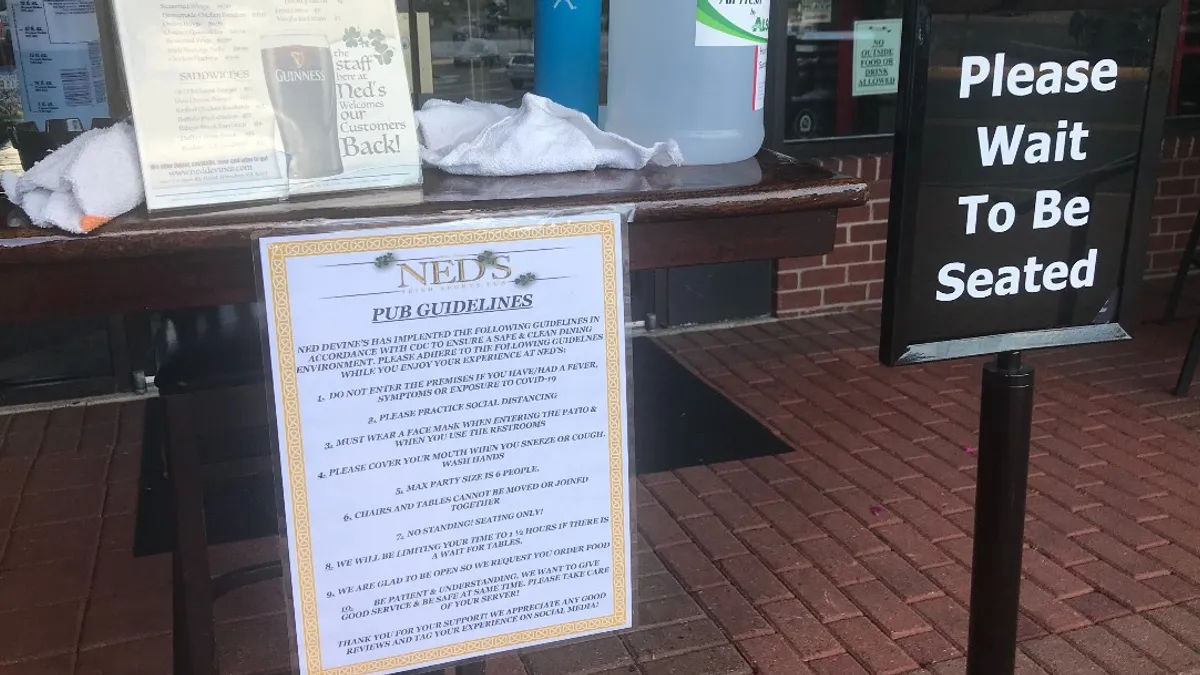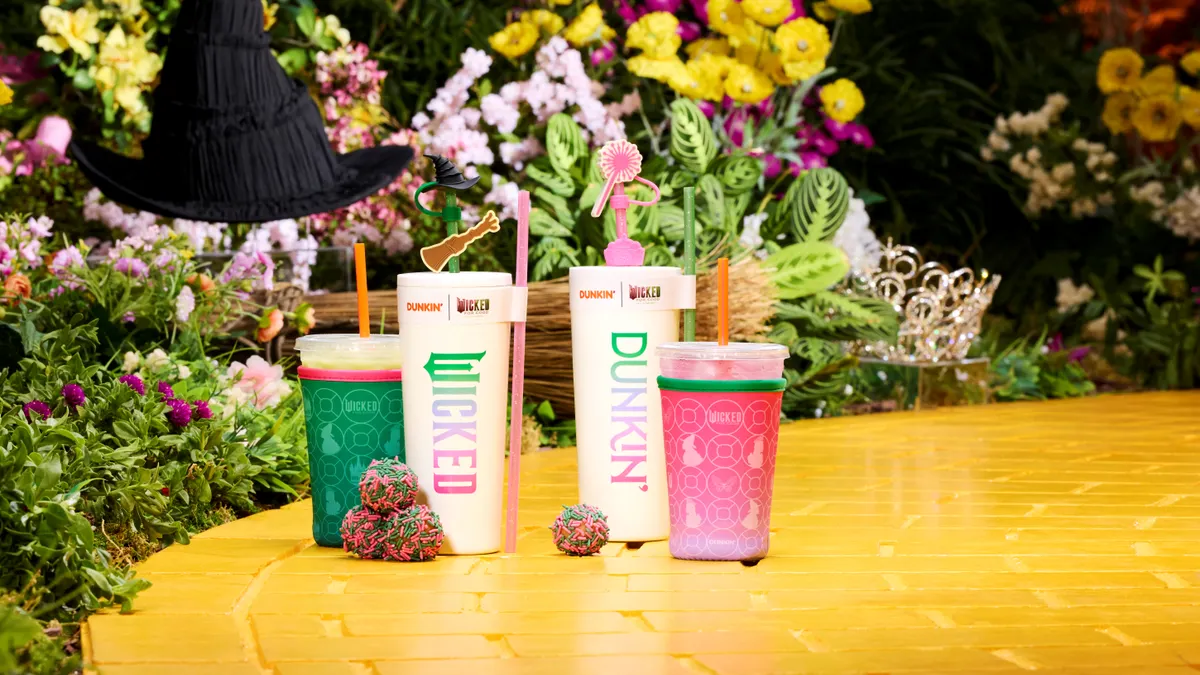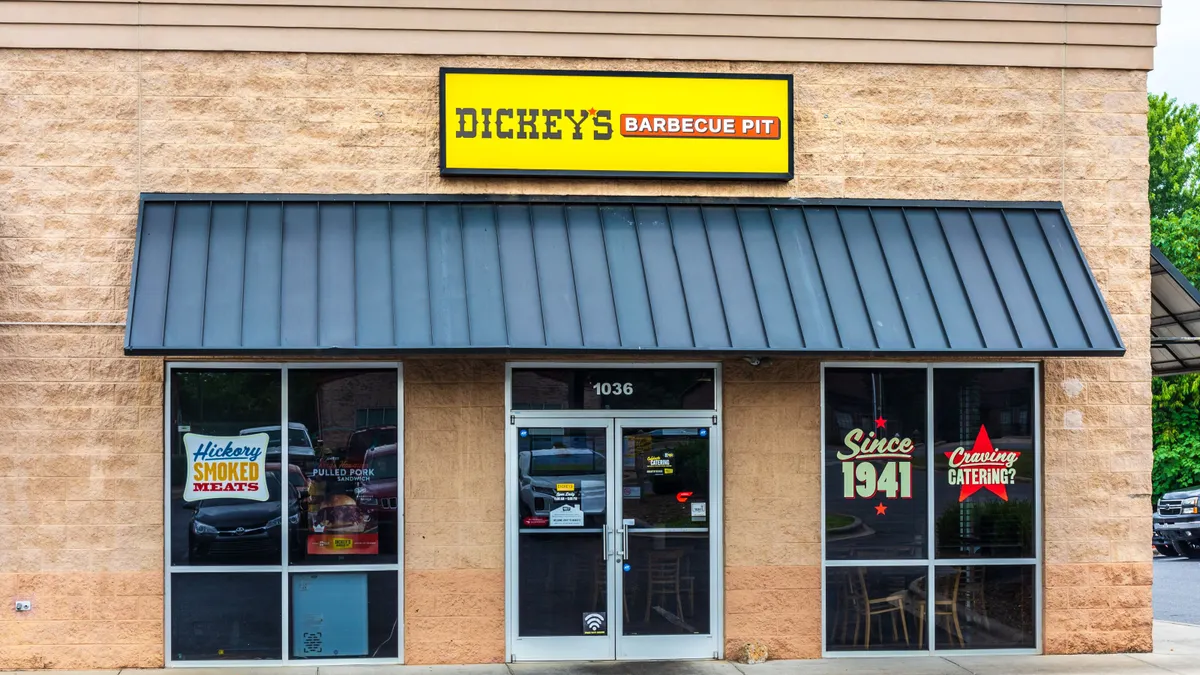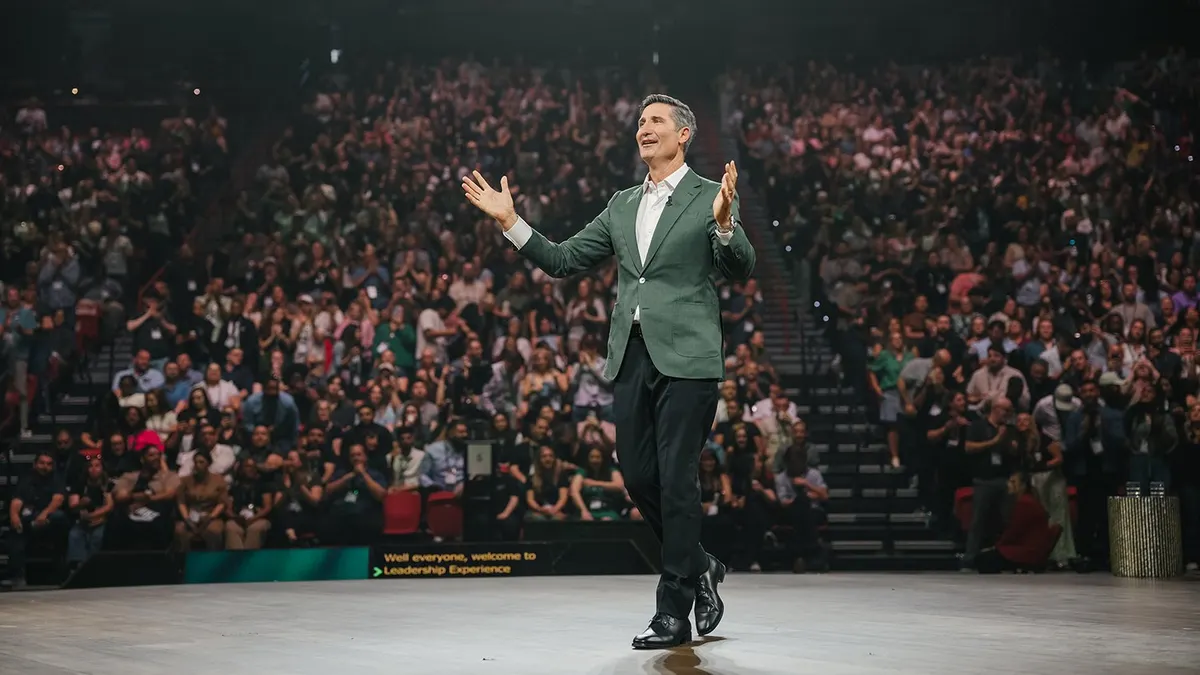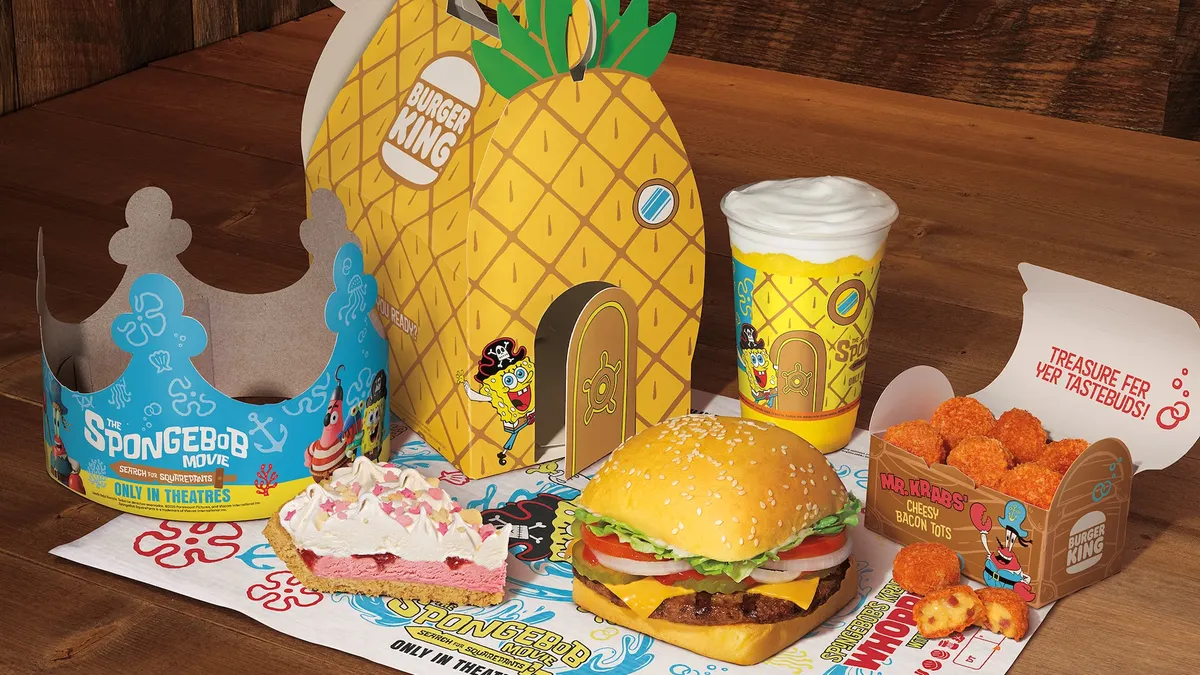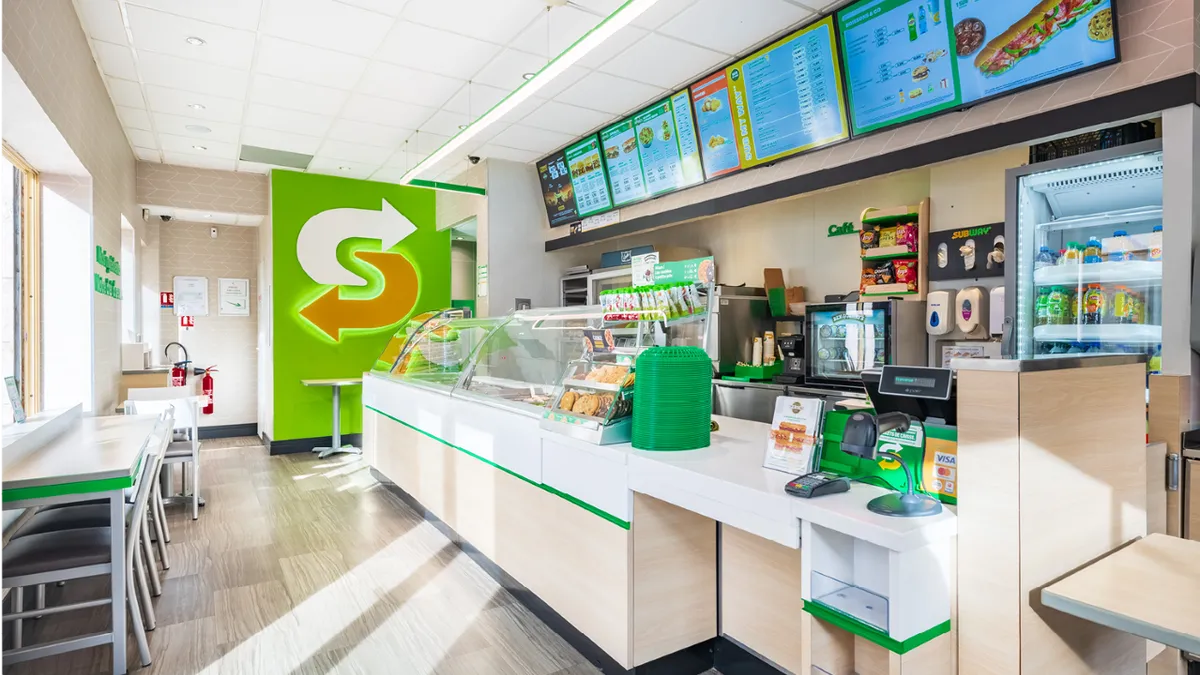This article was written last week and does not address challenges that restaurants are now facing amid nationwide protests, in conjunction with pandemic disruption. Restaurant Dive is following these developments and plans to cover their impact on the industry.
When the novel coronavirus pandemic began disrupting supply chains, Garbanzo Mediterranean Fresh realized its brand ethos could be in jeopardy.
The restaurant had built its reputation on fresh, never frozen ingredients, but needed to switch to frozen chicken to maintain a steady reserve of poultry.
It could have quietly sold the new product without informing diners. Instead, Garbanzo put the news front-and-center on store signage.
“Did we have to do that? No,” Devin Handler, VP of marketing at Garbanzo, told Restaurant Dive. “But as a brand, I feel it’s critical to let folks know anything that may or may not have changed with their favorite food. We want to be able to sleep at night knowing that we’re being as transparent and collaborative as possible.”
Restaurant messaging and marketing should evolve this way to make customers aware of how operations have changed during the pandemic and what reopening will entail, experts told Restaurant Dive.
“Restaurants need to remember that the principle by which they need to guide themselves in any tactic that they might employ is trust, customer trust,” Joel Staley, senior communications executive and media trainer at JCS Communication, told Restaurant Dive. Staley specializes in crisis communication.
This includes sending emails and posting on social media and company websites about how restaurants are adhering to social distancing standards so customers are prepared for a new dine-in experience.
“We don’t want customers coming to the restaurants and being surprised,” Staley said. “They need to know what to expect.”
This messaging needs to look professional — restaurants shouldn’t display barbecue sauce-stained, handwritten signs that look like they were scribbled down that morning, Parks Blackwell, VP of marketing and client development at PMG, a digital marketing agency, told Restaurant Dive. Messaging also needs a sense of order, she said. Signage should be in the front windows explaining what to expect before diners enter the restaurant, for example, and if customers have to wait outside within six feet of each other, they should publicize that too.
Employees should also be trained to clearly explain how these policies keep customers safe, Blackwell said.
“So many times you go into a restaurant or business and an employee just shrugs their shoulders and kind of rolls their eyes and says, ‘That’s the policy,’” Staley said. “That’s the last thing customers want to hear. It’s not comforting and it doesn’t generate trust.”
Leadership and management should model the correct behavior and communications approach that they want their employees to deliver, Staley said. This preparation can help staff better manage diners who are frustrated with or completely flout restaurant policies. Restaurant workers across the country have already faced hostility and violence from customers over face mask policies and closed dining rooms.
“I don’t envy the restaurant workers or anyone in hospitality right now. I think that their jobs are just becoming increasingly more difficult,” Blackwell said. “The more that [employees] can prepare for the easy customers who are willing to follow the guidelines, probably the easier it will be to safely deal with those who don't want to deal with the guidelines.”
How chains are marketing COVID-19 policies
Several restaurant chains have already made their operational changes very visible so diners can learn the ins and outs of increased cleanings and other safety procedures.
Atlanta-based Wing Zone, for example, issued a public service announcement on its website and social media from CEO Matt Friedman when the pandemic hit. The message detailed how delivery drivers had begun wearing masks and gloves, sanitizing hot bags and using sealed packages for takeout.
Next, Wing Zone launched an aggressive marketing campaign highlighting delivery with free offers, the addition of curbside pickup and packaged group meals.
In mid-March, fast casual Texas chain Mooyah Burgers, Fries & Shakes closed its restaurants and did a nationwide deep clean from floor to ceiling of its restaurants and encouraged the industry to do the same. The company used #RestaurantStrong on its social media to get the word out, Tony Darden, president and chief operating officer at Mooyah, told Restaurant Dive.
Mooyah also sent letters to loyalty and app users to let them know the procedures restaurants were following to ensure guest and employee safety, and shared this information on its website and social media platforms.
“Everything we do throughout this time is ... to make sure that we instill confidence in our guests and our team members so that they can come into Mooyah,” Darden said.
One of the best ways to market safety in the restaurant is to make it very visible, Darden said.
The Centers for Disease Control and Prevention recommends restaurants to require staff to wear masks, frequently wash hands, clean and disinfect touched surfaces and shared objects among other surfaces, provide proper ventilation, install shield barriers and modify layouts and procedures. Mooyah is following these guidelines and has also deployed hand sanitizer stations, single-use cups and to-go packaging, all of which visually signal to diners that the brand is taking their safety seriously.
Brands should still maintain their personas
While communicating safety measures will be key to smooth restaurant reopenings, companies should still engage diners with their unique brand voices, especially if they created playful personas on social media, Blackwell said. Burger King Italia revamped its Whopper to create a Social Distancing Whopper, for example, topping the burger with so many extra onions no one will want to come near, she said. In Germany, Burger King is testing social distancing crowns.
“I think if a brand has it in its DNA to engage with consumers and customers in a more playful and light-hearted way… they will be some of the most successful because they recognize the opportunity to … provide some relief,” Blackwell said.
Teriyaki Madness has a fun personality and brand voice that’s a little edgy, and its social media reflects that. What’s changed since the pandemic is that the brand is even more engaged with its social media to stay top of mind, but it isn’t just pushing LTOs, new ingredients or new products, Jodi Boyce, Teriyaki Madness EVP of marketing, told Restaurant Dive.
The chain is also using social media to highlight its Pay It Forward program, where customers can contribute half the cost of a meal for healthcare workers and the chain would pay the other half. It is planning to do the same where customers can support out-of-work restaurant workers.
Teriyaki Madness is also using the channel to remind people about no-contact delivery through fun gifs and light-hearted jokes.
“There are still a lot of people who are very afraid to step out of their houses so we’re letting them know you don't have to [and] we have delivery options,” Boyce said. “I don’t think [that marketing is] going to change any time soon.”
Don’t overmarket reopenings
As restaurants reopen their dining rooms, they shouldn’t oversell it, Staley said. Yes, there should be an announcement saying the dining room is open, but restaurants shouldn’t put out that announcement 19 times a day, he said. Back-to-back updates could lead to social media fatigue.
Instead, operators should start posting content that showcases new things the restaurant is doing as part of its reopening, like advertising special offers and highlighting catering and other menu items, he said.
“I think that is a much better way to engage with your customers and potential customers,” he said.
Marketers should also be careful about how they present this information to their guests across different social media platforms since each serves different purposes. Instagram, for example, tends to be more for entertainment and engagement, such as providing new recipes, and probably isn’t the best place to provide specific information about what is open, Blackwell said. Updating a bio on Instagram could be one way to provide that information by listing how many locations are open and what new policies are in place and by linking to the company’s website for more information.
Blackwell also doesn’t recommend putting messaging about new practices on Twitter or Facebook, but instead suggests reserving this important information for the company’s homepage.
Another way to market what is open is through Google My Business, which allows businesses to create free Google profiles that helps companies engage with customers, manage how they appear on Google Search and ensure Google listings are up to date, Blackwell said. That creates an easy way to show which restaurants are open and if they are open for takeout, curbside, dine-in or delivery. With more restaurants using delivery lately, it’s also important to include who is delivering and what might be paid from that delivery, especially with providers increasing their rates in recent weeks, she said.
“Having that information directly at your fingertips is probably the most important and critical component of messaging right now,” she said.
Restaurants will also need to better balance between community outreach and providing important information about its operations. Blackwell said there is a bit of COVID-19 fatigue setting in when it comes to ads and marketing.
“We get it. You’re here for us. But can you tell me what I really need to know?” Blackwell said.
Asking guests to provide feedback and analyzing social media sentiment data will help better gauge the impact of marketing and how to approach customer needs, experts said. Chains could also use this feedback to better engage with customers and employees. Burger King, for example, displayed messages of gratitude for employees on its kiosks and menu boards that it received from orders made through its app during the last week of May.
“[Customers are] going to tell you what works. They’re going to tell you what doesn’t. And then … you need to incorporate that feedback into decision-making adjustments that you make,” Staley said.
Monitoring social sentiment by location, where companies can see overall commentary, dislikes and activities to understand how people are reacting to evolving changes, will also help provide information about guests on a regional basis, Blackwell said. A sentiment analysis tool, from companies like Hootsuite, Quick Search and RapidMiner, will typically mine for opinions, use text analysis and emotion AI to comb through comments online to gauge what people are saying about a particular brand.
In states like Texas, half the population is excited about reopening and ready to get out while the other half aren’t ready to leave their homes, Blackwell said. Understanding consumer sentiment by region will be important and should be reflected in paid media, she said.
Digital messaging is a great option because it allows companies to easily pull campaigns or change messaging depending on overall sentiment, she said, because with the constant change of current events, agility will be increasingly important.
“[For] anyone who has a brick-and-mortar footprint, nothing is the same every single day,” said Blackwell.
Stay transparent, even about negative COVID-19 updates
By creating agility in marketing and messaging plans, restaurants will be able to quickly react if they have to respond to potential COVID-19 outbreaks in their stores, which has already occurred at several Chick-fil-A and Starbucks locations. When Starbucks had its first employee case of COVID-19 in downtown Seattle in early March, it provided a letter to its partners that was accessible publicly stating the actions the chain made to clean the restaurant and help the impacted employee.
“Of course there’s temptation not to divulge that type of thing because it can reflect poorly on an establishment,” Staley said. “You have to muster the courage and avoid the tendency and the fear to hold on to that information and not divulge. Again, it’s about trust.”
If operators made a mistake and clearly explain what they are doing to prevent it from happening again, customers will return, Staley said. But if they find out that an operator was not truthful and deceived customers, it will be very hard, if not impossible, to get customers back, he said.
“You want to show that you made a reasonable effort to communicate to people what happened, why it happened and what you did to fix and prevent it from happening,” Staley said.
At the end of the day, communication with customers really comes down to trust, and if restaurants break that trust with customers, they will simply go elsewhere, Staley said.
“You want to continually demonstrate and communicate what you're doing to make sure that your customers are safe and can have an enjoyable dining experience with you, despite what level of the pandemic exists at that moment,” Staley said. “And if you can communicate that, you're going to be successful.”


